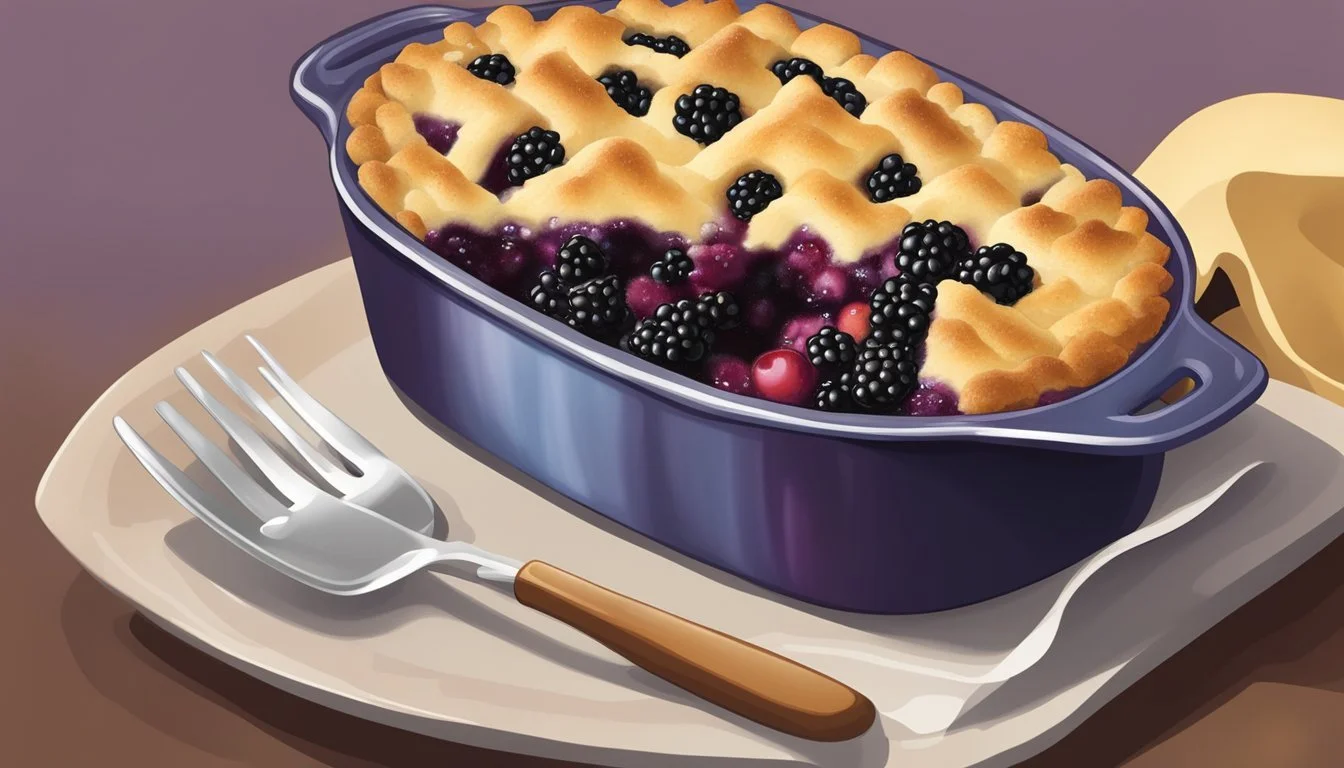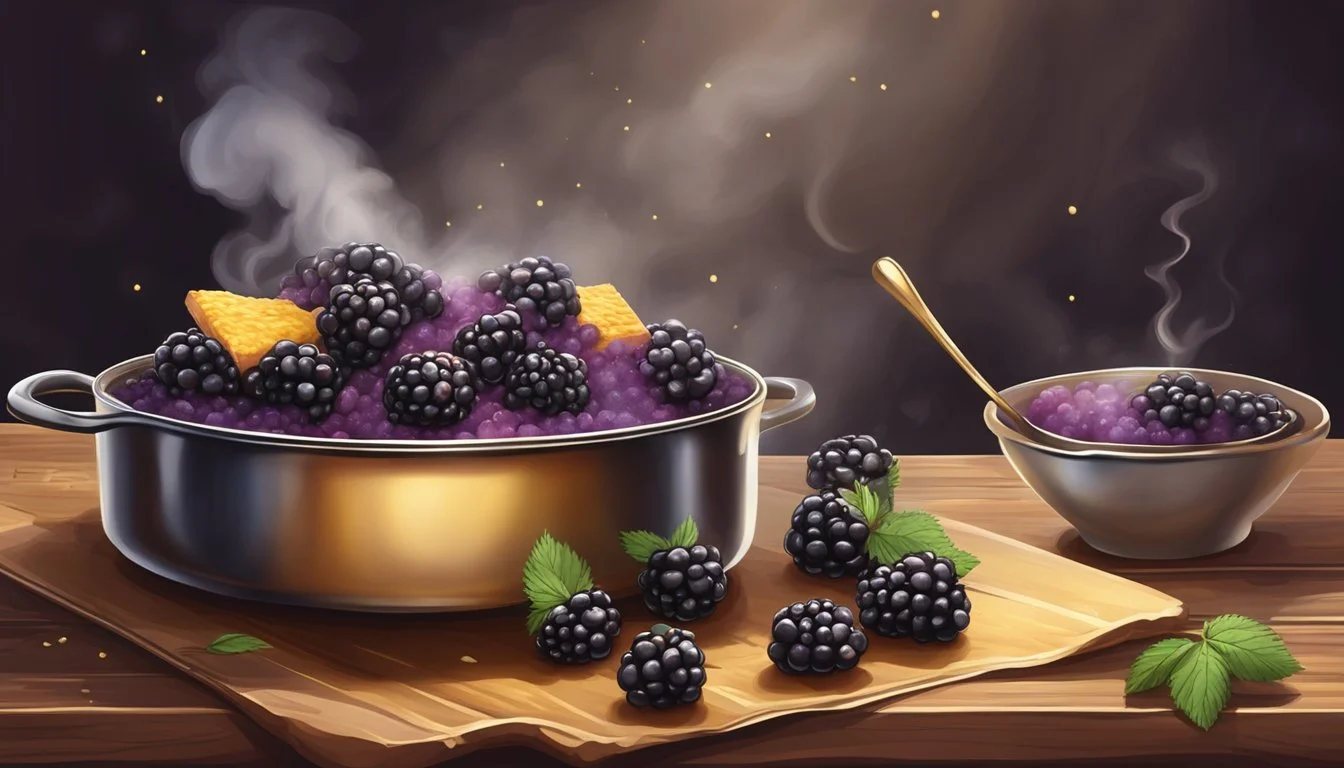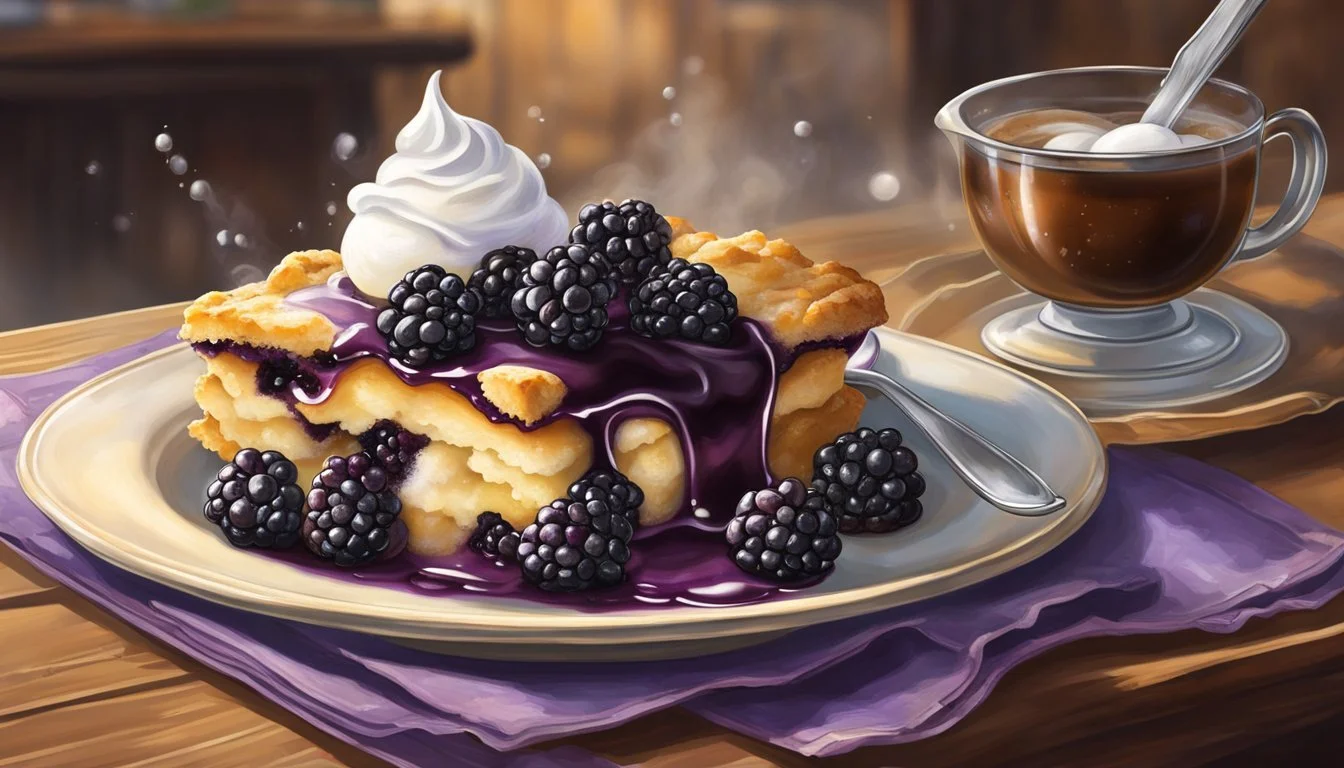Best Way to Reheat Blackberry Cobbler
Ensuring a Perfectly Crispy Crust and Luscious Filling
Blackberry cobbler, with its juicy fruit filling and flaky crust, stands as a timeless dessert appreciated by many. However, enjoying the dessert at its best often hinges on the way it is reheated. The key objective when warming up a cobbler is to preserve the integrity of the crust—keeping it flaky, not soggy—while also ensuring that the blackberry filling remains juicy and bursting with flavor. Reheating this baked good in the appropriate manner can make the difference between a merely satisfactory bite and an indulgent experience that echoes the freshness of a cobbler straight from the oven.
The method used to reheat blackberry cobbler should be careful to not undermine the texture of the dessert. Traditional ovens are typically favored for reheating, providing a consistent and enveloping heat that revives the cobbler uniformly. It is paramount to prepare the cobbler for reheating by placing it in an oven-safe dish if it's not already in one. Allowing the cobbler to reach room temperature before heating will enable more even warming, preventing the crust from burning before the filling is heated through. Individual servings might demand a shorter period in the oven, roughly 10-15 minutes, whereas a full cobbler might necessitate a longer time, around 30-45 minutes, to return to its optimal state.
The preservation of the dessert's qualities does not solely rely on the reheating method but also on the storage technique prior to reheating. To keep the crust from absorbing too much moisture, the blackberry cobbler should be stored properly—in the refrigerator or freezer, depending on the duration before it's to be consumed. The aim is to minimally disturb the dessert's original characteristics, capturing the essence of a just-baked cobbler even after it has been stored away. With a focus on these essential steps, reheating blackberry cobbler can be executed effectively, rendering a delightful dessert that is thoroughly warm, texturally appealing, and rich in taste.
Choosing the Right Reheating Method
Choosing an effective reheating method is essential to enjoy the blackberry cobbler as if it's freshly baked, preserving the flaky crust and the juicy filling. The following subsections detail the steps on how to reheat the cobbler in the oven and microwave, and also provide instructions for proper storage that influences the reheating quality.
Oven Reheating
For the best results, one should reheat the blackberry cobbler in an oven. Here's a step-by-step guide:
Preheat the oven to 350°F (175°C).
Transfer the cobbler to an oven-safe dish if it isn't in one already.
Cover the cobbler loosely with aluminum foil to prevent the crust from burning.
Place the dish on the middle rack and reheat for:
10-15 minutes for individual servings.
30-45 minutes for an entire cobbler.
Microwave Reheating
While not optimal for crust crispness, reheating in the microwave is quicker. The process is as follows:
Place a single serving of cobbler on a microwave-safe plate.
Cover with a microwave-safe lid or a damp paper towel to retain moisture.
Heat on medium power in 30-second intervals, checking for even warmth.
Storing and Reheating Instructions
Proper storage is key to a successful reheating process. Here are brief instructions:
Fridge: Store the cobbler covered in the fridge if planning to reheat within a few days.
Freeze: For longer storage, wrap the cobbler well with plastic wrap and freeze.
Upon reheating, always allow the cobbler to reach room temperature for even heating if it was frozen.
Preparing the Blackberry Cobbler for Reheating
To ensure that the blackberry cobbler reheats to a state with a flaky crust and a juicy filling, proper preparation is essential. The process varies slightly depending on whether the cobbler is frozen or at room temperature.
Thawing Frozen Cobbler
Before reheating, it's crucial to thaw frozen blackberry cobbler to prevent uneven heating. The cobbler should be transferred from the freezer to the fridge and allowed to thaw slowly, typically taking several hours or preferably overnight. A gradual thaw helps maintain the integrity of the crust and berries, whether they are fresh or were frozen.
Maintaining Moisture During Reheating
To preserve the moisture of the blackberry cobbler during reheating, cover the dish with aluminum foil, creating a seal around the edges to lock in steam. This method is beneficial in both the oven and microwave reheating to prevent the crust from drying out. If the cobbler was originally prepared with frozen blackberries, ensuring moisture retention is especially important as they can release more water upon reheating, affecting the texture.
Reheating Techniques to Preserve Quality
Proper reheating techniques are crucial when it comes to keeping a blackberry cobbler's crust flaky and its filling juicy. They must understand how a balance of temperature and time can prevent the dessert from becoming too dry or soggy.
Maintaining a Flaky Crust
A flaky crust is the highlight of any cobbler, and its preservation is fundamental during reheating. Preheating the oven to 300°F (150°C) is essential for gently warming the cobbler without overbaking the crust. Covering the cobbler with aluminum foil ensures that the heat is distributed evenly, protecting the crust from burning and allowing it to regain its delightful crispness.
Butter: Room temperature butter should be mixed into the cobbler topping to contribute to a golden brown and crisp crust.
Baking: Place the cobbler on the middle rack of the oven to ensure even baking and a uniformly flaky texture.
Keeping the Filling Juicy
The filling of a blackberry cobbler should remain as tantalizing as when it was first prepared, with the berries juicy and the fruit's natural flavors prominent.
Sugar and Lemon Juice: A sprinkle of sugar mixed with a few drops of lemon juice can be added to the blackberries before reheating to enhance the berries' natural sweetness and juiciness.
Oven Temperature: Reheating the cobbler at a moderate temperature, as noted above, helps maintain the moisture of the fruit. Time varies, with individual servings requiring 10-15 minutes and entire cobblers needing 30-45 minutes.
By following these heating guidelines, one ensures the blackberry cobbler's crust remains flaky and the fruit filling retains its juicy quality.
Enhancing the Flavor Post-Reheating
Once a blackberry cobbler has been reheated properly, accentuating its taste can transform it from merely warm to irresistibly delectable. The following suggestions focus on elevating the fruity flavor and adding that perfect finishing touch to the dessert.
Serving Suggestions
Warm blackberry cobbler pairs exquisitely with cold vanilla ice cream or a dollop of whipped cream. These additions serve a dual purpose; the contrasting temperatures can heighten the eating experience, while their creamy texture complements the crumbly, sweet biscuit topping. For optimal enjoyment, one should serve the cobbler shortly after reheating to maintain the flaky crust and juicy filling.
Vanilla Ice Cream: A scoop of vanilla ice cream not only adds richness to the dessert but also melds with the warm berries, creating a luscious sauce.
Whipped Cream: A light and airy whipped cream can add a subtle sweetness and a velvety finish.
Adding Toppings
Toppings are not merely garnishes; they enhance the complexities of the cobbler’s flavor profile. A sprinkling of raw sugar or a pat of butter right after reheating can add a nice crunch and gloss to the crust. Drizzling a little lemon juice can offer a slight tanginess that cuts through the sweetness, enhancing the natural flavor of the blackberries. A dash of cinnamon or nutmeg introduces a warm, spicy element that pairs well with the fruity flavor.
Fruit: Fresh berries on top can introduce a refreshing texture and reinforce the blackberry theme.
Spices: Sprinkling spices such as cinnamon creates an aromatic experience, while a hint of nutmeg can offer a subtle, warming undertone.
Each element chosen to accompany the blackberry cobbler should aim to enhance the cobbler's existing flavors, ensuring that the sweet, tart richness of the blackberries remains the star.
Cobbler Nutrition Information
Understanding the nutritional value of blackberry cobbler can help individuals make informed dietary choices. This section breaks down the caloric content and nutritional makeup by ingredients, focusing on a traditional blackberry cobbler recipe.
Caloric Content and Serving Size
A typical serving size of blackberry cobbler, which is approximately one cup, can vary in caloric content based on the ingredients used. On average, a serving may contain:
Calories: 300-500
This estimate is impacted by factors such as the amount of sugar and butter in the recipe.
Nutritional Breakdown by Ingredient
The primary ingredients in blackberry cobbler contribute the following nutritional values:
Blackberries: High in fiber, vitamin C, and vitamin A, blackberries are also a good source of antioxidants which can contribute to overall health.
Flour: Mainly provides carbohydrates and protein; whole wheat flour offers more fiber than white flour.
Sugar: Adds to the carbohydrate content and calories; has no nutritional value.
Butter: Contributes to the saturated fat, monounsaturated fat, and polyunsaturated fat content.
Milk: A source of calcium, potassium, and vitamin D, potentially contributing to the protein content.
Nutrient contributions also vary depending on the presence of additional ingredients such as a topping, which may increase saturated fat and sodium.
Here's a basic nutritional component table for blackberry cobbler:
Ingredient Carbohydrates Protein Saturated Fat Fiber Vitamins and Minerals Blackberries High Low None High Rich in vitamin C and vitamin A Flour High Moderate Low Low to Moderate Some iron, depending on the type Sugar High None None None None Butter Low Low High None Fat-soluble vitamins Milk Moderate Moderate Moderate None Calcium, potassium, vitamin D
Each ingredient contributes to the overall nutrition profile of blackberry cobbler. When consumed in moderation, cobbler can fit into a balanced diet.
Blackberry Cobbler Variations and Tips
Exploring different fruits and recipes allows you to enjoy a variety of flavors in your cobbler, while specific baking tips can ensure a flaky crust and juicy filling every time.
Alternative Fruits and Recipes
Blackberry Cobbler can be modified to suit different tastes by substituting blackberries with other fruits. Peach, blueberry, apple, and strawberry are excellent options that follow a similar preparation process:
Peach Cobbler: Substitute blackberries with sliced peaches and consider adding a dash of ground cinnamon or brown sugar to enhance the natural sweetness.
Blueberry Cobbler: Use blueberries instead, and mix with lemon juice for a balance of sweet and tart flavors.
Apple Cobbler: Opt for tart apples and sprinkle with cinnamon and brown sugar for a traditional fall dessert.
Strawberry Cobbler: Swap blackberries with strawberries and possibly merge with rhubarb for a classic sweet-tart combination.
These variations can be found in easy recipes on Pinterest and other recipe sharing platforms. Whether using fresh or frozen berries, adjusting the sugar quantity could be necessary to accommodate the sweetness or tartness of the fruit. Always adjust the baking time slightly, as the moisture content of different fruits can vary.
Cobbler Baking Tips
Achieving the perfect Blackberry Cobbler involves more than just following a recipe; it calls for precise techniques and careful ingredient handling:
Ingredient Quality:
Use all-purpose flour and cold, unsalted butter for the cobbler topping.
Baking powder should be fresh for proper rise.
If available, opt for fresh blackberries for a more robust flavor, although frozen blackberries work well too.
Preparation:
For the berry mixture, gently toss the berries with granulated sugar, and lemon juice to make the sauce.
For the cobbler topping, blend the dry ingredients before cutting in the butter, aiming for a sandy texture.
Baking:
Preheat the oven adequately to ensure even cooking and a golden-brown finish.
As an option, brush the cobbler topping with buttermilk or a beaten egg before baking for a richer, golden crust.
Remember, blackberry cobbler is a versatile summer dessert that's easy to make. By adopting these tips and exploring alternative recipes and fruits, anyone can create delicious berry desserts (What wine goes well with desserts?) that are both comforting and impressive.
Online Resources and Further Reading
This section provides a curated list of online resources for those looking to delve deeper into blackberry cobbler recipes and nutritional insights. Readers can find a wealth of knowledge ranging from easy-to-follow recipes to detailed nutrition information to better understand their dietary intake when enjoying this classic dessert.
Cobbler Recipes and Inspiration
For anyone seeking easy blackberry cobbler recipes or creative ideas for berry desserts, the following resources offer a plethora of options:
Pinterest: A visual platform filled with numerous cobbler recipes. Users can simply search for "easy blackberry cobbler recipe" or "berry desserts" to find an array of inspirational pins with step-by-step guides and photographs.
Tastes Better From Scratch: A food blog that provides an easy dessert variant of the traditional blackberry cobbler, complete with detailed baking instructions.
CopyKat Recipes: Offers a straightforward easy blackberry cobbler recipe, emphasizing simplicity and flavor.
Love From The Oven: Readers can find a recipe combining ripe blackberries with the perfect mix of sugar and lemon juice to ensure juiciness with a flaky crust.
Nutritional Information Sources
For those interested in the nutritional aspects of their meals, including the calorie content and macros of their favorite cobbler, these sources can be informative:
MyFitnessPal: By inputting "blackberry cobbler" in their database, individuals can track their nutritional intake, making it easier to fit this dessert into a balanced diet.
USDA FoodData Central: Provides comprehensive nutrition information for almost any food, including home-baked desserts like blackberry cobbler. Users can search for ingredients used in the cobbler to get detailed data on their nutritional value.
Utilizing these resources, readers can ensure they are enjoying their home-cooked blackberry cobbler in the healthiest way possible while exploring an array of easy recipes.
Common Questions About Reheating Cobbler
When it comes to enjoyment of a blackberry cobbler, reheating it correctly is crucial to maintaining the delicate flakiness of the crust and the juiciness of the filling. This section addresses common concerns around reheating techniques and storage to ensure that the cobbler remains as delicious as it was when first made.
FAQ on Reheating Techniques
Can you reheat a cobbler in the oven? Yes, an oven is recommended for reheating cobbler. Preheat your oven to 350°F, then place the cobbler in an oven-safe dish (such as a baking or casserole dish) and cover with foil. Reheat individual servings for 10-15 minutes and a whole cobbler for 30-45 minutes. A lattice crust or a drop biscuit topping benefits particularly from this method, as the gentle heat helps retain its texture.
Is microwave reheating recommended for cobbler? While microwaving is quicker, it's not ideal for blackberry cobbler with a flaky crust. A microwave might make the crust soggy and overcook the fruit, leading to a less desirable texture.
Tips for Cobbler Storage
How should you store leftover cobbler? After cooling to room temperature, cover the cobbler with plastic wrap or aluminum foil and store it in the fridge. It's typically best to consume refrigerated cobbler within 3-4 days for optimal freshness.
Can you freeze cobbler? Yes, cobbler can be frozen. Wrap it tightly in plastic wrap and then aluminum foil, or place it in a freezer-safe container. Freeze for up to 3 months. When ready to serve, thaw in the fridge and then reheat as above. This technique works well for make-ahead events or extending the life of your dessert.
Note: When preparing a blackberry cobbler to freeze, utilizing a thickener like tapioca helps maintain the filling's consistency during the freeze-thaw process. Additionally, if using a turbinado or coarse sugar for the topping before freezing, it could provide a nice texture upon reheating.







